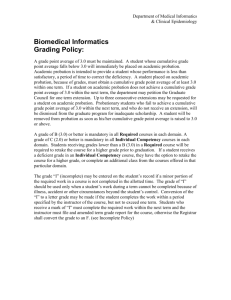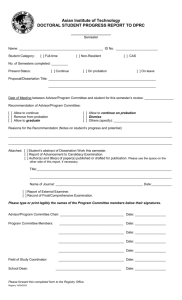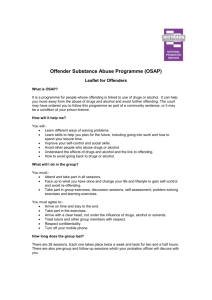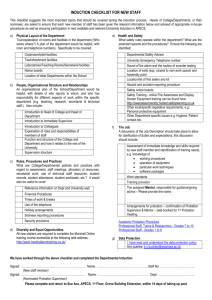Filed 7/23/07 P. v. Lo CA4/1 NOT TO BE PUBLISHED IN OFFICIAL
advertisement
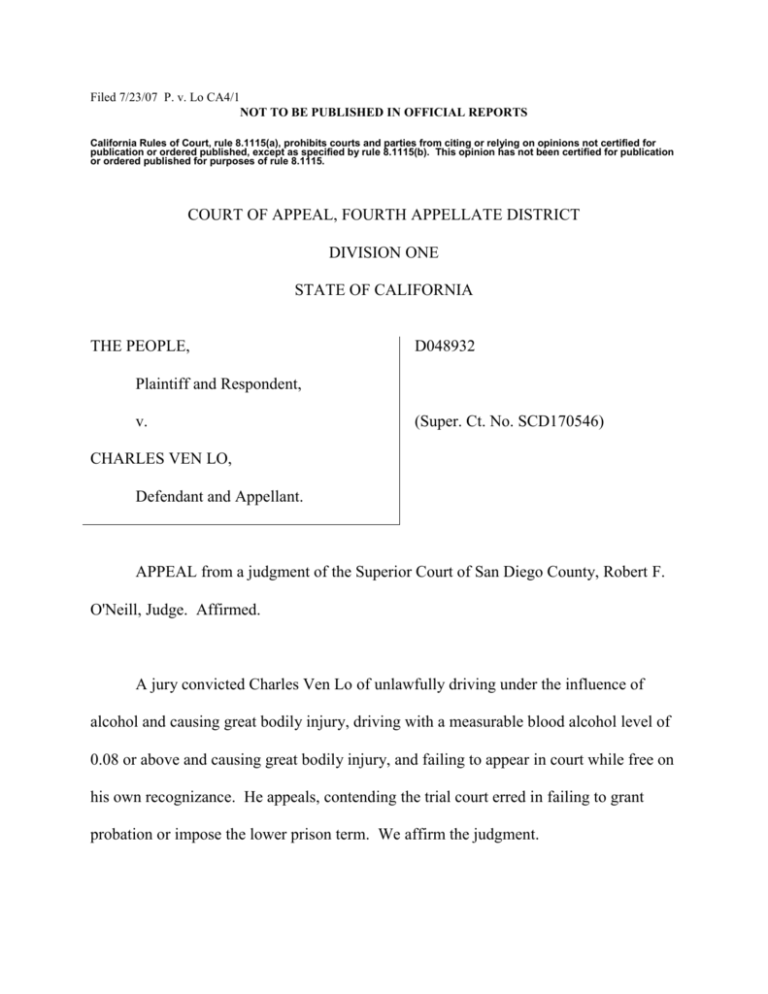
Filed 7/23/07 P. v. Lo CA4/1 NOT TO BE PUBLISHED IN OFFICIAL REPORTS California Rules of Court, rule 8.1115(a), prohibits courts and parties from citing or relying on opinions not certified for publication or ordered published, except as specified by rule 8.1115(b). This opinion has not been certified for publication or ordered published for purposes of rule 8.1115. COURT OF APPEAL, FOURTH APPELLATE DISTRICT DIVISION ONE STATE OF CALIFORNIA THE PEOPLE, D048932 Plaintiff and Respondent, v. (Super. Ct. No. SCD170546) CHARLES VEN LO, Defendant and Appellant. APPEAL from a judgment of the Superior Court of San Diego County, Robert F. O'Neill, Judge. Affirmed. A jury convicted Charles Ven Lo of unlawfully driving under the influence of alcohol and causing great bodily injury, driving with a measurable blood alcohol level of 0.08 or above and causing great bodily injury, and failing to appear in court while free on his own recognizance. He appeals, contending the trial court erred in failing to grant probation or impose the lower prison term. We affirm the judgment. FACTUAL AND PROCEDURAL BACKGROUND In October 2002, Lo attended a concert on Shelter Island. During the evening, he drank several beers and was feeling "a little bit of a buzz." Driving home from the concert, he reached the scene of an accident where officers from the San Diego Harbor Police were redirecting traffic. Lo drove around the cars in front of him and hit Tim Barkett, a San Diego Harbor Police officer who was photographing the accident scene. When questioned, Lo said he had not been drinking, although a subsequent blood test showed that he had a blood alcohol level of .19. In January 2006, the San Diego County District Attorney charged Lo with causing great bodily injury while driving under the influence of alcohol, causing great bodily injury while driving with a measurable blood alcohol level of 0.08 or above, and failing to appear on his own recognizance while released from custody pending judgment on a felony offense. The jury found Lo guilty of all counts, and the court sentenced him to seven years, eight months in prison. This sentence consisted of the middle term of two years for driving under the influence and causing injury along with three years for the great bodily injury enhancement, and eight months for failing to appear on his own recognizance with a two-year enhancement for committing this offense while released from custody on an earlier felony offense. DISCUSSION 1. Denial of Probation Lo contends the trial court erred in denying him probation. Such a decision will only be reversed if it is held to be an abuse of discretion. In reviewing for abuse of 2 discretion, we must view the circumstances in the light most favorable to the trial court. The decision will only be reversed if, under these circumstances, no reasonable judge would have reached the same conclusion. (People v. Downey (2000) 82 Cal.App.4th 899, 909-910.) Lo argues that errors in the probation report led to an improper decision to deny probation. Specifically, he alleges that the probation report erroneously states that (1) a flare pattern was in use at the scene of the accident when he committed the offense; (2) he had a prior admitted offense; and (3) at trial he denied being drunk on the day of the collision. However, the trial court's recitation of its reasons for its sentencing choices (including the denial of probation) did not refer to any of these circumstances. Furthermore, Lo brought the misstatement regarding a flare pattern to the court's attention before sentencing, and the other two errors are inconsequential. While it is true there are no prior admitted offenses in the record, Lo does have two previous convictions for drunk driving. In addition, although Lo did not directly deny he had been drunk on the day of the collision, his testimony permitted an inference of denial. Lo also argues that two of the aggravating factors relied on by the court as a basis for denying him probation were not applicable. First, he argues that the nature and circumstances of the crime are not more serious than other instances of the same crime. However, although Lo did not drive through a flare pattern, he did in fact drive past flashing police lights before hitting Officer Barkett. Lo contends that he did not ignore the police officers directing traffic, but rather was too inebriated to notice them. Even if we assume this is true, it does not reduce the seriousness of his offense. 3 Second, Lo argues that the probation report inaccurately depicted Officer Barkett as a particularly vulnerable victim. Although California Rules of Court, rule 4.421(a)(3) (all further rule references are to the California Rules of Court) states that a particularly vulnerable victim is an aggravating factor in sentencing, when a pedestrian is hit by a drunk driver an element of vulnerability is inherent in the crime itself, and the victim cannot be considered particularly vulnerable under rule 4.421(a)(3). (People v. Piceno (1987) 195 Cal.App.3d 1353, 1357-1358.) The rule relied on by the trial court, however, does not require a particularly vulnerable victim, but simply states that the vulnerability of the victim is a factor in granting or denying probation. (Rule 4.414(a)(3).) Rule 4.414(a)(3) therefore allows a trial court more leeway than rule 4.421(a)(3) in considering victim vulnerability for the purpose of denying probation. (People v. Weaver (2007) 149 Cal.App.4th 1301, 1315-1316, & fn. 15; but see People v. McNiece (1986) 181 Cal.App.3d 1048, 1053, 1058-1059, overruled on another ground in People v. Flood (1998) 18 Cal.4th 470.) Finally, Lo argues that the number of factors supporting a grant of probation outweigh the number of factors supporting a denial of probation. Even if this is true, it is irrelevant, since a trial court is not obligated to rely on such a preponderance of factors. Probation is granted or denied at the discretion of the court and Lo has the burden of showing that the court's decision was arbitrary and capricious. (People v. Superior Court (Du) (1992) 5 Cal.App.4th 822, 825.) He has failed to do so. The trial court relied heavily on the purpose of the sentencing laws to protect the public and punish and deter unlawful conduct, noting Lo's prior convictions, his blood alcohol level and his continued 4 insistence that he should be given lenience because he did not intend to injure Officer Barkett. This rational basis is enough to uphold the denial of probation. 2. Failure to Select the Lower Term The middle term sentence is ordinarily selected unless imposition of the upper or lower term is justified by aggravating or mitigating circumstances. (Rule 4.420(a).) Lo argues that the court should have imposed the lower sentence for each count, because the probation report listed one possible aggravating factor and two possible mitigating factors. The court took these circumstances into account and determined that they did not warrant a departure from the middle term. The trial court has broad discretion when making such a determination, and it was not an abuse of discretion for the court to choose the presumptive sentence. (People v. Giminez (1975) 14 Cal.3d 68, 72.) Lo also contends that because he is an alcoholic, the court erred in failing to select the lower term. He argues that courts may not consider alcoholism to be an aggravating factor, and must consider it to be a mitigating factor. (People v. Simpson (1979) 90 Cal.App.3d 919, 928.) Rule 4.423(b)(2) states that it is a mitigating factor if the defendant was suffering from a mental or physical condition that significantly reduced his culpability for the crime. The fact that a defendant is an alcoholic is not automatically a mitigating factor; the alcoholism must also reduce culpability for the crime. In the case of a repeat drunk driver, his alcoholism does not reduce the culpability for driving under the influence, but rather establishes a basis for concluding that a longer sentence is necessary to protect the public. (People v. Reyes (1987) 195 Cal.App.3d 957, 963-964.) The trial court was not required to find alcoholism to be a mitigating factor; it was only 5 required to consider the possibility that it might be and here it did so, rejecting that possibility. (Id. at p. 960.) Although the trial court found Lo's prior alcohol-related convictions to be aggravating factors, these convictions are distinguishable from the underlying condition of alcoholism. In addition, the probation report does not list Lo's alcoholism as a possible mitigating factor because Lo testified that he did not have a drinking problem. After Lo later underwent a psychological evaluation, the forensic examiner's report indicated that he had a problem with alcohol at the time of the collision, and this report was included in Lo's sentencing memorandum and statement in mitigation. The trial court considered Lo's alcoholism, and ultimately found that it was not compelling as a mitigating factor. Finally, even if the trial court had improperly relied on mistakes in the probation report or failed to adequately consider Lo's alcoholism in imposing sentence, Lo has not shown that these errors were prejudicial. In other words, Lo has not shown that it is reasonably probable, based on the entire case, that a more favorable result would have been reached in the absence of these errors. (People v. Watson (1956) 46 Cal.2d 818, 836.) 6 DISPOSITION The judgment is affirmed. McINTYRE, J. WE CONCUR: McCONNELL, P. J. McDONALD, J. 7

